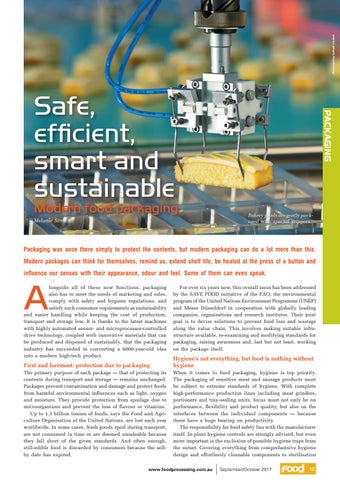Photo courtesy Gerhard Schubert
Modern food packaging Melanie Streich
Bakery goods are gently packaged with special grippers.
Packaging was once there simply to protect the contents, but modern packaging can do a lot more than this. Modern packages can think for themselves, remind us, extend shelf life, be heated at the press of a button and influence our senses with their appearance, odour and feel. Some of them can even speak.
A
longside all of these new functions, packaging also has to meet the needs of marketing and sales, comply with safety and hygiene regulations, and satisfy such consumer requirements as sustainability and easier handling while keeping the cost of production, transport and storage low. It is thanks to the latest machines with highly automated sensor- and microprocessor-controlled drive technology, coupled with innovative materials that can be produced and disposed of sustainably, that the packaging industry has succeeded in converting a 6000-year-old idea into a modern high-tech product.
For over six years now, this overall issue has been addressed by the SAVE FOOD initiative of the FAO, the environmental program of the United Nations Environment Programme (UNEP) and Messe Düsseldorf in cooperation with globally leading companies, organisations and research institutes. Their joint goal is to devise solutions to prevent food loss and wastage along the value chain. This involves making suitable infrastructure available, re-examining and modifying standards for packaging, raising awareness and, last but not least, working on the package itself.
First and foremost: protection due to packaging
Hygiene’s not everything, but food is nothing without hygiene
The primary purpose of each package — that of protecting its contents during transport and storage — remains unchanged. Packages prevent contamination and damage and protect foods from harmful environmental influences such as light, oxygen and moisture. They provide protection from spoilage due to microorganisms and prevent the loss of flavour or vitamins. Up to 1.3 billion tonnes of foods, says the Food and Agriculture Organisation of the United Nations, are lost each year worldwide. In some cases, fresh goods spoil during transport, are not consumed in time or are deemed unsaleable because they fall short of the given standards. And often enough, still-edible food is discarded by consumers because the sellby date has expired.
When it comes to food packaging, hygiene is top priority. The packaging of sensitive meat and sausage products must be subject to extreme standards of hygiene. With complete high-performance production lines including meat grinders, portioners and tray-sealing units, focus must not only be on performance, flexibility and product quality, but also on the interfaces between the individual components — because these have a huge bearing on productivity. The responsibility for food safety lies with the manufacturer itself. In-plant hygiene controls are strongly advised, but even more important is the exclusion of possible hygiene traps from the outset. Covering everything from comprehensive hygiene design and effortlessly cleanable components to sterilisation
www.foodprocessing.com.au
September/October 2017
13
BULK HANDLING, STORAGE & LOGISTICS PACKAGING
Safe, efficient, smart and sustainable
